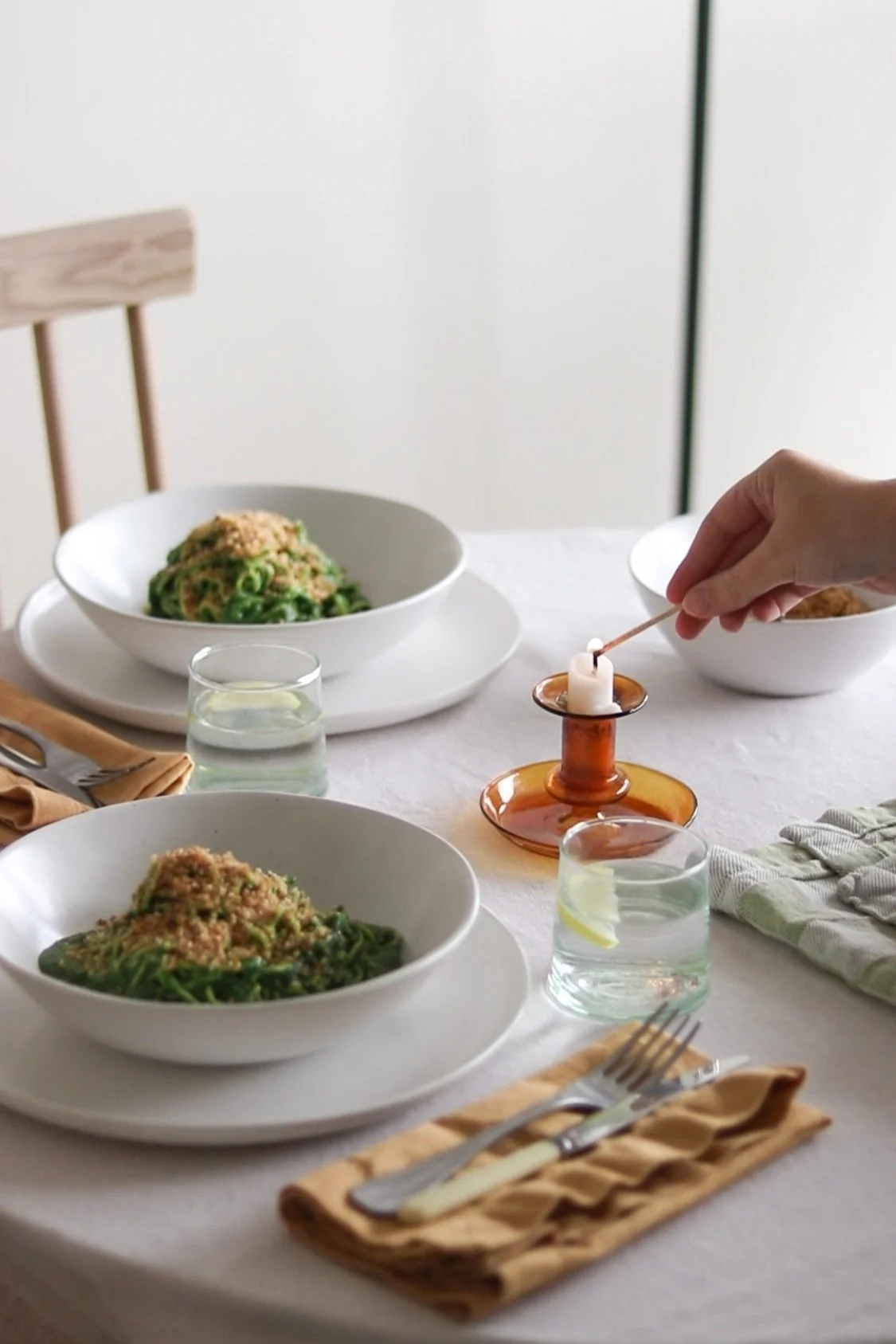Cavolo nero tagliarini with lemon pangrattato
Autumn is my favourite season and I’d make a strong case for the ingredients that come with it too. Certain ingredients feel decidedly autumnal, including Cavolo Nero, squash varieties and earthy mushrooms. When I look at seasonal vegetables my first thought is ‘how can I turn this into a pasta sauce?’. Cavolo Nero makes for a delicious sauce, not only for its alluring forest green colour but its slight bitterness is a great match for the sweetness of the caramelised onion and garlic used in this recipe. I imagine anchovies would also be a great addition when you add the garlic and chilli if you wanted to.
| Serves 4 |
INGREDIENTS
2 onions, finely sliced
2 large or 3 small garlic cloves, finely sliced
1 red chilli, roughly chopped
400g cavolo nero
50g stale bread, blitzed to breadcrumbs
30g butter, cubed
1/2 lemon, zest only
For the tagliarini
4 eggs
400g 00 pasta flour
Semolina flour
METHOD
To make the tagliarini, weigh out the 00 pasta flour and make a well in the middle for your eggs. Crack in the eggs, and either using your fingers or a fork, start swirling in a circular motion to start incorporating the flour into the eggs.
You only want to do this until the liquid is thick enough so it doesn’t spill all over the work surface, this is important as if it starts to form a dough too soon it becomes harder to incorporate the rest of the flour. Use both hands to push the remaining flour from the outside until the middle. Fold and press the dough until all flour is absorbed and the dough comes together.
Knead for around 10 minutes or until smooth, elastic and the dough bounces back easily.
Rest in cling film or with a bowl over for 30 minutes.
In the meantime you can get on with the sauce by cooking the sliced onions in 2 tbsp olive oil with a pinch of salt over a low heat for around 30-40 minutes, or until very soft and caramelised. Stir regularly to stop them from catching. For the last 5 minutes, add the sliced garlic and chilli.
Cook the Cavolo Nero in salted water for 4-5 minutes or until wilted. Reserving some of the cooking water, transfer to a food processor with the cooked onion mixture and a ladleful of the cooking water. Blitz until it’s a sauce consistency but don’t overdo it.
To make the pangrattato, heat a tablespoon of olive oil in another frying pan over a medium heat. Add the breadcrumbs and cook for around 5-10 minutes over a medium heat until golden brown, stirring often. Turn off the heat and add the lemon zest and a pinch of salt. Set aside.
Cut your pasta dough in half and pop the other half back in the cling film. Dust your work surface with some 00 or semolina flour and flatten it out with your fingers. Set the pasta machine at its widest setting and roll the pasta through it.
Roll it out to the next setting on the machine and then fold the pasta in half. Set it back to 0 and roll the pasta through. Repeat this process 5-6 times, on the last two folds try to fold as neatly as possible so the pasta shape stays uniform. Keep dusting with flour if it starts to feel too sticky.
Cut the pasta into two to make it a more manageable length, then roll each piece through each setting, starting on widest and finishing at the point when you can see your hand through the dough when you hold it up, on my Marcato Atlas this is setting 6.
Repeat these steps with the remaining pasta dough, then liberally dust each piece with semolina flour before using the tagliarini attachment to pass the dough through. As it’s a thinner setting the pasta can tend to stick together more so dust with more semolina flour after cutting.
Bring a large pan of water to a rolling boil. Season generously with salt until it tastes like the sea.
Add the tagliarini and cook until al dente, this should only take a couple of minutes if that. While pasta cooks, gently heat the Cavolo Nero sauce in large frying pan. Add the cooked pasta to the sauce and toss to coat with the cubed butter and a little pasta cooking water. Check for seasoning and serve with the lemony pangrattato.
